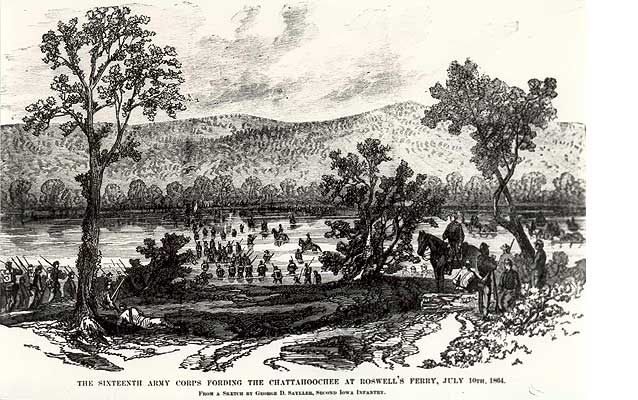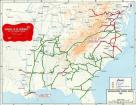Last updated: November 2, 2018
Lesson Plan
The Atlanta Campaign

- Grade Level:
- Upper Elementary: Third Grade through Fifth Grade
- Subject:
- Literacy and Language Arts,Math,Science,Social Studies
- Lesson Duration:
- 90 Minutes
- State Standards:
- NATIONAL/STATE STANDARDS:
Georgia Performance Standards: SS5H1c, SS5H1e, SS5G2a, SS5G2b, S5CS4a, S5CS4b, S5CS4c, & S5CS4d. Common Core Standards: 5.MD.1 & CCSS.ELA-Literacy.W.5.1 - Thinking Skills:
- Remembering: Recalling or recognizing information ideas, and principles. Understanding: Understand the main idea of material heard, viewed, or read. Interpret or summarize the ideas in own words. Applying: Apply an abstract idea in a concrete situation to solve a problem or relate it to a prior experience. Analyzing: Break down a concept or idea into parts and show the relationships among the parts.
Essential Question
What happened during the Atlanta Campaign?
Objective
Students will understand:
The causes, major events, and consequences of the Civil War
The effects of war on the North and South
What happened during the Atlanta Campaign
How to use ideas of system, model, change, and scale in exploring scientific and technological matters
Background
During the 1800s, the Chattahoochee River witnessed a large amount of industrial growth along its banks. Mills were built and used water power to make items such as cotton, wool, paper, tenting, roping, flannels, and yarn. Many of these goods were sent to the main railroad line in Atlanta, where they could be shipped to other parts of the country. The mills were an important part of Atlanta’s industry, and the river was an important part in keeping the mills running.
In 1864, during the Civil War, General William T. Sherman crossed the Chattahoochee River and ordered his troops to burn the mills, therefore weakening the South’s development. Because a number of the mills were making uniforms and supplies for the Confederate soldiers, their destruction was a hard hit to parts of the southern troops. Following the Civil War, however, many of the mills were rebuilt and their ruins can still be seen along the river today.
Two industrially important mills along the Chattahoochee River were the Marietta Paper Mill at Sope Creek and the Ivy Woolen Mill at the mouth of Vickery Creek. Let’s take a closer look at each of these mills and see how they were run back in the 1800s.
Preparation
- Water Wheel Science Connection
- Interpretive Guide for Vickery Creek Mills
- Roswell Mills Math Warm-up
- Roswell Mills Different Perspectives Worksheet
- Interpretive Guide For Sope Creek Mill
- Marietta Paper Mill Warm-up
- Marietta Paper Mill Different Perspective Worksheet
- Memories of a Teenage Girl
- Railroads of the Confederacy Map, 1861
- Railroads of the United States Map, 1870
- Atlanta Area reading
- Battle of Atlanta Map, 1864
- Eyewitness Report Rubric

HISTORIC MAP, RAILROADS OF THE CONFEDERACY
Map of southeastern United States showing Confederate railroads and their gauge in 1861. View

HISTORIC MAP, RAILROADS ROUTES IN 1870
This pre-visit lesson will evaluate the map of the United States showing the railroad routes in 1870 to identify reasons for capturing Atlanta. View

MEMORIES OF A TEENAGE GIRL

UNDERSHOT WATER WHEEL
Demonstrates how an undershot water wheel works. View
Lesson Hook/Preview
In 1864, during the Civil War, General William T. Sherman crossed the Chattahoochee and ordered his troops to burn the mills, therefore weakening the South’s development. Because a number of the mills were making uniforms and supplies for the Confederate soldiers, their destruction was a hard hit to parts of the southern troops. Following the Civil War, however, many of the mills were rebuilt and their ruins can still be seen along the river today.
Procedure
Pre-visit
- Introduce the lesson with a guided student analysis of the drawing entitled The Sixteenth Army Corps Fording the Chattahoochee at Roswell’s Ferry, July 19th, 1864.
- Discuss the 4 basic needs of humans
- Discuss how in the 1860s obtaining these needs were different than today.
- Discuss the importance of transportation during the war.
- Discuss the importance of railroads to the military commanders during the Civil War.
- Leave students with a reading of Atlanta Area.
On-site Visit
- Tour various sites and record on graphic organizer ways that you would be feeling if you were one of the following characters:
-
- Confederate Soldier-defending Atlanta
- Slave
- Civilian-mill worker, farmer
- Union Soldier-Attacking Atlanta
Post-visit
Eyewitness Report from different perspectives
- Discuss Atlanta Campaign
- Discuss what an Eyewitness Report is
- Read “Memories of a Teenage Girl”
- Write Eyewitness Reports using Rubric as a guide
- Share
Vocabulary
Atlanta Campaign
Water Wheel
Mills
Confederates
Unions
Assessment Materials
Students will write an eyewitness report from the perspective of a person involved in the Atlanta Campaign. A rubric is included.
Performance Tasks:
Eyewitness Report
Pretend that you are a slave, mill worker, Union soldier or Confederate soldier. Write a letter to a loved one describing the events that occurred. Use factual information but include your perspective of the events.
Enrichment Activities
This lesson connects to the park because it is a Civil War park. The students will be able to visit actual historical Civil War locations.
STEM: Students could research how buildings were constructed by slave labor. They could use fire records to recreate a scale model of the Ivy Woolen Mill or the Marietta Paper Mill.
Additional Resources
http://www.heritagesandysprings.org/Sandy-Springs-History/civil-war.html
http://www.history.com/topics/atlanta-campaign
“Sherman's Atlanta Campaign and the Importance of Railroads” http://www.kennesaw.edu/civilwarera/lessonplans/6-8/sherman_railroads.pdf
Civil War Series, The Campaign for Atlanta https://www.nps.gov/history/history/online_books/civil_war_series/7/sec6.htm
CIVIL WAR MATH - batchelk@hsd.k12.or.us
The Water Wheel http://www.technologystudent.com/energy1/wtrwhl1.htm
Sope Creek Manufacturing Complex by Everett E. Bronski, Jr. Georgia Institute of Technology
March 10, 1978
http://www.eyewitnesstohistory.com/gtburg.htm
http://www.atlantahistorycenter.com/cms/Hardtack+Recipe/460.html
Contact Information
Email us about this lesson plan
